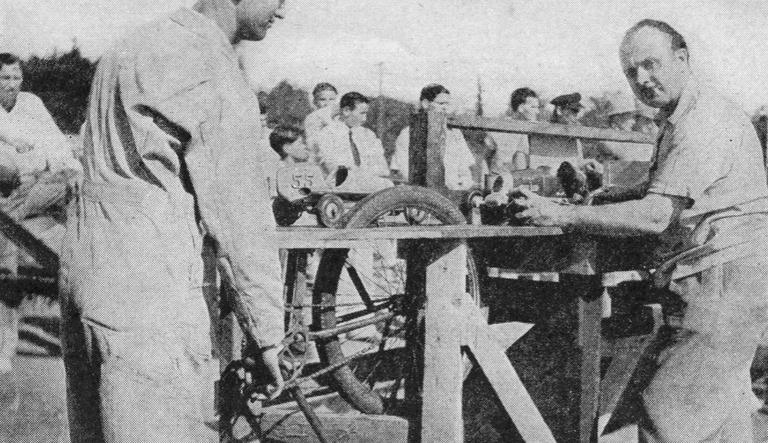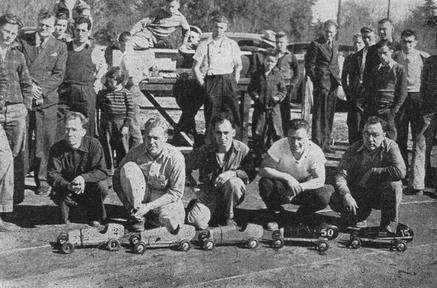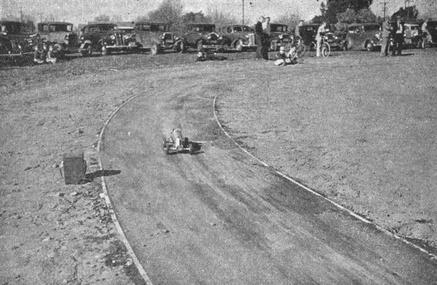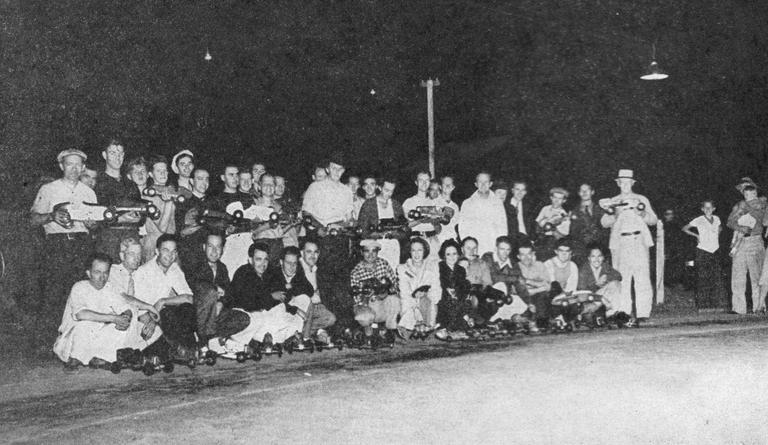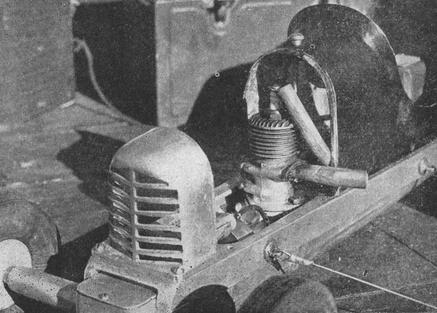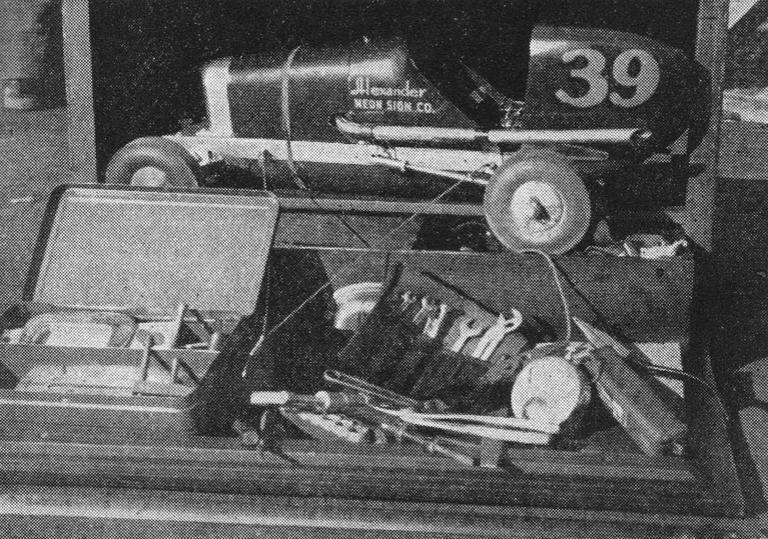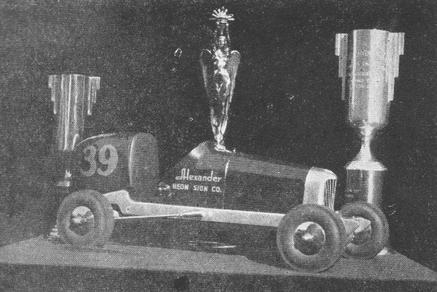mitecars.com
email: [email protected]
In the Beginning... Part 1. It Started in California
According to most accounts, the hobby of building and racing gas powered miniature race cars had its beginnings in early 1937 on a dirt field on the southwestern side of Los Angeles. This large parcel of vacant land at the corner of Rosecrans and Western Avenues served as the flying field for model airplane enthusiasts across the region and was the site of regularly scheduled weekend free-flight competitions. Even though the flying field, affectionately called the “Dust Bowl” by local hobbyists , was rough and dirty, it attracted large numbers of modelers for those weekend flying contests.
But those Sunday afternoon free-flight competitions were not without their drawbacks. Many contestants wrapped up their weekend by taking home a badly damaged airplane as a result of crashing into the hard dirt surface of the flying field. And others returned home with nothing at all, a result of their plane having caught a thermal and rising high in the air as it disappeared far into the southern California sky.
Those hazards were not lost on one Los Angeles model airplane enthusiast, Tom Dooling. Writing in the June 1940 issue of Model Craftsman magazine, Dooling noted:
“On a Sunday evening in the early part of 1937, my brothers and I were sitting around the fire in the living room, discussing the day’s activities at the Los Angeles model airplane field. At that time, I was an ardent model airplane fan, had a plane of my own, and like most amateurs in aerodynamics, I managed to bring my plane home in pieces after each Sunday’s flying.
“This particular Sunday evening, the discussion came around to the possibility of building a miniature car powered by a small gas engine similar to the motor used in my airplane. Being like any other average American, I have always had the desire to tinker with gadgets of one sort or another, and this model car idea could not be passed up. The following week, with the aid of my brothers, we assembled our first car.
“This little buggy had the beauty and grace of a one-legged duck—and with all its ugliness. The basic principle proved a success, and we immediately started designs for a new one. Since that time, we have made several different models”.
The first car that Tom Dooling, along with his brothers Russell and Harris, built in early 1937 had a wood frame and body and was powered by a Gwin Aero engine taken from one of his model airplanes. The car was a front wheel drive design with friction drive. The front wheels were “turned in” so that the car would run in a circle and no external tether was attached to the frame. Unfortunately, Dooling’s first attempts were hardly successful, with the car usually running less than a full lap before it would sputter to a stop. But the Dooling brothers continued their development of the car, spurred on in part by the good-natured ribbing that their early failures were getting from their fellow model airplane enthusiasts.
As the Dooling brothers’ car became more reliable, other hobbyists brought out their own creations to test at the weekly get-togethers at Rosecrans and Western. And not surprisingly, as their numbers grew, the prospect of speed contests among cars began to fill the air.
The first organized miniature race car competition was held at the Los Angeles model airplane flying field in September 1937. A widely-advertised free-flight flying contest was scheduled for that Sunday and the model airplane event attracted a large number of both competitors and onlookers. Meanwhile, a small group of miniature car racers staked out one corner of the field for their own competition. Up to six cars were raced in a circle at one time with each car having a hand-held chalk line attached to a wire bridle mounted on the side of the car. The competitors stood in the center of the circle and faster cars passed slower cars by paying out more line and raising it higher to allow the faster car to pass on the outside. Slower cars were kept to the inside and stalled cars were pulled into the center of the circle.
One of the fellows who had come out to watch the model airplane contest, and who was subsequently attracted to the noise of the miniature car races, was a real estate developer from Fresno, California by the name of Richard E. “Dick” Hulse. A 1990 letter from Hulse to the editor of AMRCC (American Miniature Race Car Collectors) News noted that:
“We were living in Fresno at the time and had driven down to L.A. for the weekend so that my wife could visit her family. I drove over to the field and fortunately picked the weekend that Tom (Dooling) and other early day hobbyists were racing the first miniature race cars I had ever seen.
“Those early cars had model airplane wheels and wood bodies. The little cars used model airplane engines and used friction drives to drive the front wheels. There were no metal gears in any of the cars I saw – just a fiber disc on the drive wheel axle that was pressed against the engine’s flywheel to turn the axle.
“Racing was really a “blast”. The fellows all stood in the center of the flat dirt track with a carpenter’s chalk line attached to the bridle of the car. A helper would start the car’s engine with a quick flip of the drive wheel or spin the wheel on a bicycle tire with the bike upside down.
“With the car running, the helper would launch the car and the man in the circle was off and racing. If the car was slow, he would keep it close to the center, but if it was fast, he would pass another car on the outside of the circle by lifting his line over the head of the man with the slower car.
“When several people were racing it was a lively and exciting thing to see the racers standing up and passing their lines over the heads of the others and some squatting down trying to keep their cars from tangling with the fast cars. You can imagine what this looked like when 5 or 6 people were racing. It really became a “mess” when a car’s engine stopped.
“Usually a race lasted as long as the fuel lasted (since) there was no way to stop a car until the engine stopped or a helper on the outside of the track either grabbed it or stopped it with a blanket.
“To say the least, it was a real “circus” and often there were more people watching the cars than the airplanes”.
Hulse’s letter continued: “I was immediately fascinated by the “Doodle Bugs” when I first saw them but did not get into the spirit of things for several months.
“In the early spring of 1938 the weather got very hot in Fresno and one warm evening my wife and I decided to go to a movie. We had to park in a garage across the street from the theater. The garage was owned by Ray Snow’s father and Ray took care of the theater traffic.
“When we drove in the garage I heard a model aircraft engine running. I asked Ray if he was building an airplane and he said “No. I’m building a race car”. With this comment I was immediately interested and told my wife to go ahead into the theater and that I would be along as soon as I had talked to Ray for a few minutes. The “few minutes” lasted for an hour when my wife came looking for me and we went back and saw the end of the movie. However, the next day I saw Ray again and asked him if he would assemble a car for me. He told me that the Hobby Shop, which incidentally was in a corner of the theater building across from the garage, had everything needed to build a car. It was one of the Doolings’ first kits and I bought a Dennymite engine to drive the car. Ray put the car together and I helped some, but mostly it was Ray’s excellent workmanship that did the job.
“There was no track built for racing at the time in Fresno so it was first tested by running it in Snow’s garage when there were no cars to park. Ray had mounted a wheel with an axle in it and had it weighted down with a couple of sand bags.
“The car ran in a 30-foot circle very well. Later, Ray did some “porting” of the cylinder exhaust and fuel by-pass and the Dennymite really “purred”.”
In January 1939, Hulse and a small group of Fresno hobbyists that were bitten by the “racing bug” formed the Model Midget Association of Fresno. Dick Hulse was elected president of the club. One of the members of the group, Wes Coates, owned a ranch just outside the city limits near the west entrance of the Fresno County Fairgrounds, and a crude track was built on that property. The first track was simply a smooth dirt circle but with a permanent pole in the center and a steel cable replacing the hand-held carpenter’s chalk line used in the past. Only one car was raced at a time.
That flat, dusty dirt track was soon replaced with another circular track 330 feet (1/16th mile) in circumference and four feet wide. The racing surface was one-inch thick asphalt and was initially quite smooth. But, that track also soon proved to be unsatisfactory. The track was too narrow and the layer of asphalt was too thin, and on warm days the asphalt became quite soft and started to break up. Within a few weeks, the track surface became too bumpy to be used. So the Fresno club replaced the asphalt surface with a concrete track, still 1/16th mile in circumference, but now with an eight foot wide racing surface which sloped down one inch to the foot toward the center of the track. The club also added lights so that races could be held in the evening. That track proved to be a very successful design.
By the spring of 1939, armed with an enthusiastic and supportive group of club members and arguably the finest tether car track in the state, Dick Hulse organized the first regional tether car race to be held in the country. Hosted by the Fresno Model Midget Association, 36 entrants from across California participated in the open invitational event which was called the “California Championship Model Midget Race” held on March 26. Unfortunately, the weather did not cooperate and the event was forced to be moved indoors to the Fresno Auditorium where floor space limitations restricted the size of the track to a 260 foot circumference circle instead of the larger 330 foot outdoor track.
Nonetheless, the event was a rousing success and by 4:00 p.m., when the final cars had completed their heats, the winner of the event was Dick Hulse with his Ray Snow-built racer. Second place went to Carl Lehman of Fresno, followed by Tom Dooling of Los Angeles and Walt Cave of Fresno. Hulse’s winning car was a first-model Dooling front wheel drive machine powered by a Dennymite engine which Snow had modified extensively.
But while Hulse’s car created quite a stir among the over 4,000 spectators attending the event, his little racer would soon become a national phenomenon, spreading even more excitement across the country.
Fresno's Walt Cave (left) starting his FWD racer using an upside-down bicycle..
After starting his car, Walt Cave places his racer on a piece of sheet metal to keep the spinning drive wheels from digging up the track surface.
Early group of Fresno-area racers at the dirt track on Wes Coates' (2nd from left) ranch.
Dooling FWD racer at speed on the short-lived asphalt surface Fresno track..D
Typical Dennymite powered, front wheel drive Dooling race car, circa 1939.
By 1939 the Fresno club had grown and their track was now paved and lighted.
Dick Hulse's Dennymite powered Dooling FWD race car, built by Ray Snow.
Winner of the March 26, 1939 "California Championship Model Midget Race"
To continue this article...

